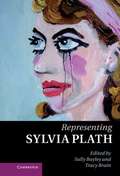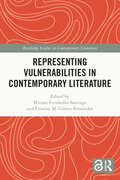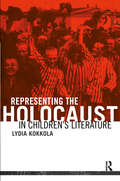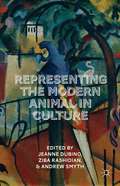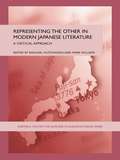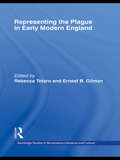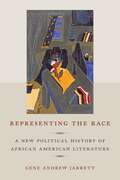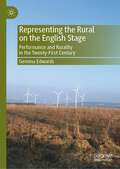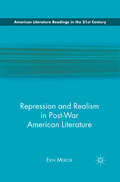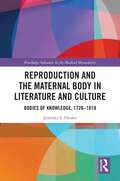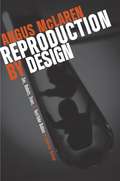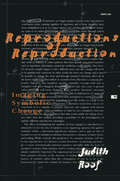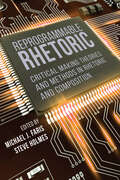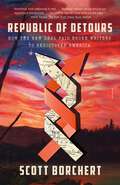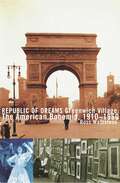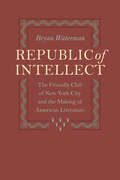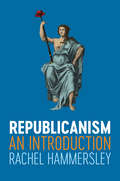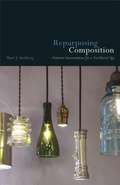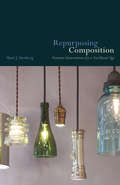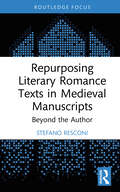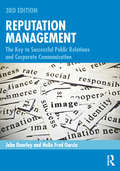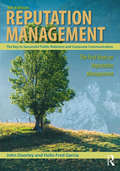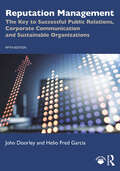- Table View
- List View
Representing Sylvia Plath
by Sally Bayley Tracy BrainInterest in Sylvia Plath continues to grow, as does the mythic status of her relationship with Ted Hughes, but Plath is a poet of enduring power in her own right. This book explores the many layers of her often unreliable and complex representations and the difficult relationship between the reader and her texts. The volume evaluates the historical, familial and cultural sources which Plath drew upon for material: from family photographs, letters and personal history to contemporary literary and cinematic holocaust texts. It examines Plath's creative processes: what she does with materials ranging from Romantic paintings to women's magazine fiction, how she transforms these in multiple drafts and the tools she uses to do this, including her use of colour. Finally the book investigates specific instances when Plath herself becomes the subject matter for other artists, writers, film makers and biographers.
Representing Vulnerabilities in Contemporary Literature (Routledge Studies in Contemporary Literature)
by Miriam Fernández-Santiago Cristina M. Gámez-FernándezRepresenting Vulnerabilities in Contemporary Literature includes a collection of essays exploring the ways in which recent literary representations of vulnerability may problematize its visibilization from an ethical and aesthetic perspective. Recent technological and scientific developments have accentuated human vulnerability in many and different ways at a cross-national, and even cross-species level. Disability, technological, and ecological vulnerabilities are new foci of interest that add up to gender, precarity and trauma, among others, as forms of vulnerability in this volume. The literary visualization of these vulnerabilities might help raise social awareness of one’s own vulnerabilities as well as those of others so as to bring about global solidarity based on affinity and affect. However, the literary representation of forms of vulnerability might also deepen stigmatization phenomena and trivialize the spectacularization of vulnerability by blunting readers’ affective response towards those products that strive to hold their attention and interest in an information-saturated, global entertainment market.
Representing Women: Law, Literature, and Feminism
by Susan Sage Heinzelman Zipporah Batshaw WisemanThis anthology explores the provocative intersection between feminist, literary, and legal theories. Written by feminist thinkers from law and literature, discourses that each produce culturally powerful representations of women, these essays contest the boundaries that usually separate these disciplines and thereby alter the possibilities of those representations that have traditionally disempowered women.Beginning with an exploration of the ways in which women are represented--how they either tell or have their stories told in literature, in the law, in a courtroom--this collection demonstrates the interrelatedness of the legal and the literary. Whether considering the status of medieval women readers or assessing the effectiveness and extent of contemporary rape law reform, the essays show that power first comes with telling one's own story, and that the degree and effect of that power are determined by the cultural significance of the forum in which the story is presented. But telling the story is not enough. One must also be aware of how the story is contained within traditional constructs or boundaries and is thus limited in its effects, as Carol Sanger's essay on mothers and legal/sexual identity makes clear. One must also recognize how a story might perpetuate an ideological agenda that is not in the best interests of the storyteller, as Elizabeth Butler Cullingford shows in her reading of Yeats's "Leda and the Swan" and one must know the historical context of a story and of its telling, as Anne B. Goldstein's essay on lesbian narratives discloses.Breaking down the boundaries between law and literature, this anthology makes evident the ways in which the effect of women's stories has been constrained and expands the range of possibilities for those who represent women, tell women's stories, or present women's issues. Representing Women makes the retelling of old stories about women compelling and the telling of new ones both necessary and possible.Contributors. Kathryn Abrams, Linda Brodkey, Rita Copeland, Elizabeth Butler Cullingford, Margaret Anne Doody, Susan B. Estrich, Michelle Fine, Anne B. Goldstein, Angela P. Harris, Susan Sage Heinzelman, Christine L. Krueger, Martha Minow, Carol Sanger, Judy Scales-Trent
Representing the Holocaust in Children's Literature: Representing The Holocaust In Youth Literature (Children's Literature and Culture)
by Lydia KokkolaFirst Published in 2003. Routledge is an imprint of Taylor & Francis, an informa company.
Representing the Modern Animal in Culture
by Jeanne DubinoExamining a wide range of works, from Gulliver's Travels to The Hunger Games, Representing the Modern Animal in Culture employs key theoretical apparatuses of Animal Studies to literary texts. Contributors address the multifarious modes of animal representation and the range of human-animal interactions that have emerged in the past 300 years.
Representing the Other in Modern Japanese Literature: A Critical Approach (The University of Sheffield/Routledge Japanese Studies Series)
by Mark Williams Rachael HutchinsonRepresenting the Other in Modern Japanese Literature looks at the ways in which authors writing in Japanese in the twentieth century constructed a division between the ‘Self’ and the ‘Other’ in their work. Drawing on methodology from Foucault and Lacan, the clearly presented essays seek to show how Japanese writers have responded to the central question of what it means to be ‘Japanese’ and of how best to define their identity. Taking geographical, racial and ethnic identity as a starting point to explore Japan's vision of 'non-Japan', representations of the Other are examined in terms of the experiences of Japanese authors abroad and in the imaginary lands envisioned by authors in Japan. Using a diverse cross-section of writers and texts as case studies, this edited volume brings together contributions from a number of leading international experts in the field and is written at an accessible level, making it essential reading for those working in Japanese studies, colonialism, identity studies and nationalism.
Representing the Plague in Early Modern England (Routledge Studies In Renaissance Literature And Culture Ser. #14)
by Rebecca TotaroThis collection offers readers a timely encounter with the historical experience of people adapting to a pandemic emergency and the corresponding narrative representation of that crisis, as early modern writers transformed the plague into literature. The essays examine the impact of the plague on health, politics, and religion as well as on the plays, prose fiction, and plague bills that stand as witnesses to the experience of a society devastated by contagious disease. Readers will find physicians and moralists wrestling with the mysteries of the disease; erotic escapades staged in plague-time plays; the poignant prose works of William Bullein and Thomas Dekker; the bodies of monarchs who sought to protect themselves from plague; the chameleon-like nature of the plague as literal disease and as metaphor; and future strains of plague, literary and otherwise, which we may face in the globally-minded, technology-dependent, and ecologically-awakened twenty-first century. The bubonic plague compelled change in all aspects of lived experience in Early Modern England, but at the same time, it opened space for writers to explore new ideas and new literary forms—not all of them somber or horrifying and some of them downright hilarious. By representing the plague for their audiences, these writers made an epidemic calamity intelligible: for them, the dreaded disease could signify despair but also hope, bewilderment but also a divine plan, quarantine but also liberty, death but also new life.
Representing the Race: A New Political History of African American Literature
by Gene Andrew JarrettThe political value of African American literature has long been a topic of great debate among American writers, both black and white, from Thomas Jefferson to Barack Obama. In his compelling new book, Representing the Race, Gene Andrew Jarrett traces the genealogy of this topic in order to develop an innovative political history of African American literature. Jarrett examines texts of every sort—pamphlets, autobiographies, cultural criticism, poems, short stories, and novels—to parse the myths of authenticity, popular culture, nationalism, and militancy that have come to define African American political activism in recent decades. He argues that unless we show the diverse and complex ways that African American literature has transformed society, political myths will continue to limit our understanding of this intellectual tradition.Cultural forums ranging from the printing press, schools, and conventions, to parlors, railroad cars, and courtrooms provide the backdrop to this African American literary history, while the foreground is replete with compelling stories, from the debate over racial genius in early American history and the intellectual culture of racial politics after slavery, to the tension between copyright law and free speech in contemporary African American culture, to the political audacity of Barack Obama’s creative writing. Erudite yet accessible, Representing the Race is a bold explanation of what’s at stake in continuing to politicize African American literature in the new millennium.
Representing the Rural on the English Stage: Performance and Rurality in the Twenty-First Century
by Gemma EdwardsThis book explores how the English rural has been represented in contemporary theatre and performance. Exploring a range of plays, forms, and contexts of theatre production, Representing the Rural celebrates the lively engagement with rurality on English stages since 2000, constituting the first full study of theatrical representations of rural life. Interdisciplinary in its approach, this book draws on political philosophy and cultural geography in its definitions of rurality and Englishness, and works with key theoretical concepts such as nostalgia and ethnonationalism. Covering a range of perspectives from the country garden in Mike Bartlett’s Albion to agricultural labour in Nell Leyshon’s The Farm, the enclosure acts in D.C. Moore’s Common to Black rural history in Testament’s Black Men Walking, the book shows how theatre and performance can open up different ways of reading rural geographies, histories, and lives. While Representing the Rural is aimed at students and researchers of theatre and performance, its interdisciplinary scope means that it has wider appeal to other disciplines in the arts and humanities, including geography, politics, and history.
Repression and Realism in Post-War American Literature
by Erin MercerThis study of fiction produced in America in the decade following 1945 examines literature by writers such as Kerouac and Bellow. It examines how, though such fiction seemed to resolutely avoid the events and implications of World War II, it was still suffused with dread and suggestions of war in imagery and language.
Reproduction and the Maternal Body in Literature and Culture: Bodies of Knowledge, 1726-1818 (Routledge Advances in the Medical Humanities)
by Jennifer S. HenkeThis book examines a selection of texts to discuss how midwifery, obstetrics and women’s bodies were constructed during the (long) eighteenth century, and how these material-discursive entanglements between science, medicine, literature and culture have shaped society's views of pregnancy, childbirth and reproduction.Drawing on theories from disciplines such as feminist new materialism, this book traces the history of both the reproductive body and the pluralistic medical knowledges that attended to pregnancy and childbirth during the Enlightenment and early Romanticism in Britain. It identifies the significance of literary and cultural artefacts in this knowledge formation, including the materiality of the female reproductive body itself, and raises awareness of myths about pregnancy and childbirth that persist today. This book features chapters exploring Jonathan Swift’s Gulliver’s Travels, John Cleland’s Fanny Hill, Laurence Sterne’s Tristram Shandy, Eliza Fenwick’s Secresy, Or: The Ruin on the Rock, Mary Wollstonecraft’s Maria, Or: The Wrongs of Woman, and Mary Shelley’s Frankenstein.Reproduction and the Maternal Body in Literature and Culture is an innovative and interdisciplinary contribution to the medical humanities and feminist philosophy of science and will interest scholars from a range of backgrounds, including literature and cultural studies, midwifery, medicine and history.
Reproduction by Design: Sex, Robots, Trees, and Test-Tube Babies in Interwar Britain
by Angus MclarenModernity in interwar Europe frequently took the form of a preoccupation with mechanizing the natural; fears and fantasies revolved around the notion that the boundaries between people and machines were collapsing. Reproduction in particular became a battleground for those debating the merits of the modern world. That debate continues today, and to understand the history of our anxieties about modernity, we can have no better guide than Angus McLaren. In Reproduction by Design, McLaren draws on novels, plays, science fiction, and films of the 1920s and '30s, as well as the work of biologists, psychiatrists, and sexologists, to reveal surprisingly early debates on many of the same questions that shape the conversation today: homosexuality, recreational sex, contraception, abortion, euthanasia, sex change operations, and in vitro fertilization. Here, McLaren brings together the experience and perception of modernity with sexuality, technology, and ecological concerns into a cogent discussion of science's place in reproduction in British and American cultural history.
Reproductions of Reproduction: Imaging Symbolic Change
by Judith RoofReproductions of Reproduction is about the loss of the paternal metaphor and how the ensuing scramble to relocate it has set off a series of representational crises. Examining the sudden popularity of such figures as cyborgs, bodybuilders, and vampires; shifts in legislation about abortion, paternity and copyright; the transition to a digital-based society; the emergence of lesbian and gay studies; the growing infatuation with hyper-realistic patterns in television, this book argues that each of these manifestations represents an attempt to resituate the paternal metaphor. While this shift affects our understandings of everything from narratives to law to time, it also suggests a point of potential political intervention, allowing us to identify the full implications of these changes.
Reprogrammable Rhetoric: Critical Making Theories and Methods in Rhetoric and Composition
by Steve Holmes Michael J. FarisReprogrammable Rhetoric offers new inroads for rhetoric and composition scholars’ past and present engagements with critical making. Moving beyond arguments of inclusion and justifications for scholarly legitimacy and past historicizations of the “material turn” in the field, this volume explores what these practices look like with both a theoretical and hands-on “how-to” approach. Chapters function not only as critical illustrations or arguments for the use of reprogrammable circuits but also as pedagogical instructions that enable readers to easily use or modify these compositions for their own ends. This collection offers nuanced theoretical perspectives on material and cultural rhetorics alongside practical tutorials for students, researchers, and teachers to explore critical making across traditional areas such as wearable sensors, Arduinos, Twitter bots, multimodal pedagogy, Raspberry Pis, and paper circuitry, as well as underexplored areas like play, gaming, text mining, bots, and electronic monuments. Designed to be taught in upper division undergraduate and graduate classrooms, these tutorials will benefit non-expert and expert critical makers alike. All contributed codes and scripts are also available on Utah State University Press’s companion website to encourage downloading, cloning, and repurposing. Contributors: Aaron Beveridge, Kendall Gerdes, Kellie Gray, Matthew Halm, Steven Hammer, Cana Uluak Itchuaqiyaq, John Jones, M.Bawar Khan, Bree McGregor, Sean Morey, Ryan Omizo, Andrew Pilsch, David Rieder, David Sheridan, Wendi Sierra, Nicholas Van Horn
Republic of Detours: How the New Deal Paid Broke Writers to Rediscover America
by Scott BorchertA New York Times Book Review Editors' ChoiceAn immersive account of the New Deal project that created state-by-state guidebooks to America, in the midst of the Great Depression—and employed some of the biggest names in American lettersThe plan was as idealistic as it was audacious—and utterly unprecedented. Take thousands of hard-up writers and put them to work charting a country on the brink of social and economic collapse, with the aim of producing a series of guidebooks to the then forty-eight states—along with hundreds of other publications dedicated to cities, regions, and towns—while also gathering reams of folklore, narratives of formerly enslaved people, and even recipes, all of varying quality, each revealing distinct sensibilities. All this was the singular purview of the Federal Writers’ Project, a division of the Works Progress Administration founded in 1935 to employ jobless writers, from once-bestselling novelists and acclaimed poets to the more dubiously qualified. The FWP took up the lofty goal of rediscovering America in words and soon found itself embroiled in the day’s most heated arguments regarding radical politics, racial inclusion, and the purpose of writing—forcing it to reckon with the promises and failures of both the New Deal and the American experiment itself. Scott Borchert’s Republic of Detours tells the story of this raucous and remarkable undertaking by delving into the experiences of key figures and tracing the FWP from its optimistic early days to its dismemberment by the House Committee on Un-American Activities. We observe notable writers at their day jobs, including Nelson Algren, broke and smarting from the failure of his first novel; Zora Neale Hurston, the most widely published Black woman in the country; and Richard Wright, who arrived in the FWP’s chaotic New York City office on an upward career trajectory courtesy of the WPA. Meanwhile, Ralph Ellison, Studs Terkel, John Cheever, and other future literary stars found encouragement and security on the FWP payroll. By way of these and other stories, Borchert illuminates an essentially noble enterprise that sought to create a broad and inclusive self-portrait of America at a time when the nation’s very identity and future were thrown into question. As the United States enters a new era of economic distress, political strife, and culture-industry turmoil, this book’s lessons are urgent and strong.
Republic of Dreams: Greenwich Village: The American Bohemia, 1910-1960
by Ross WetzsteonIf the twentieth century was the American century, it can be argued that it was more specifically the New York century, and Greenwich Village was the incubator of every important writer, artist, and political movement of the period. From the century's first decade through the era of beatniks and modern art in the 1950s and '60s, Greenwich Village was the destination for rebellious men and women who flocked there from all over the country to fulfill their artistic, political, and personal dreams. It has been called the most significant square mile in American cultural history, for it holds the story of the rise and fall of American socialism, women's suffrage, and the commercialization of the avant-garde. One Villager went so far as to say that "everything started in the Village except Prohibition," and in the 1940s, the young actress Lucille Ball said, "The Village is the greatest place in the world." What other community could claim a spectrum ranging from Henry James to Marlon Brando, from Marcel Duchamp to Bob Dylan, from Gertrude Vanderbilt Whitney to Abbie Hoffman? The story of the Village is, in large part, the stories old Villagers have told new Villagers about former Villagers, and to tell its story is in large part to tell its legends. Republic of Dreams presents the remarkable, outrageous, often interrelated biographies of the giants of American journalism, poetry, drama, radical politics, and art who flocked to the Village for nearly half a century, among them Eugene O'Neill, whose plays were first produced by the Provincetown Players on Macdougal Street, for whom Edna St. Vincent Millay also wrote; Jackson Pollock, who moved to the Village from Wyoming in 1930 and was soon part of the group of 8th Street painters who would revolutionize Western painting; E. E. Cummings, who lived for years on Patchin Place, as did Djuna Barnes; Max Eastman, who edited the groundbreaking literary and political journal The Masses, which introduced Freud to the American public and also published Sherwood Anderson, Amy Lowell, Upton Sinclair, Maksim Gorky, and John Reed's reporting on the Russian Revolution. Republic of Dreams is beautifully researched, outspoken, wise, hip, exuberant, a monumental, definitive history that will endure for decades to come.
Republic of Intellect: The Friendly Club of New York City and the Making of American Literature (New Studies in American Intellectual and Cultural History)
by Bryan WatermanIn the 1790s, a single conversational circle—the Friendly Club—united New York City's most ambitious young writers, and in Republic of Intellect, Bryan Waterman uses an innovative blend of literary criticism and historical narrative to re-create the club's intellectual culture. The story of the Friendly Club reveals the mutually informing conditions of authorship, literary association, print culture, and production of knowledge in a specific time and place—the tumultuous, tenuous world of post-revolutionary New York City. More than any similar group in the early American republic, the Friendly Club occupied a crossroads—geographical, professional, and otherwise—of American literary and intellectual culture. Waterman argues that the relationships among club members' novels, plays, poetry, diaries, legal writing, and medical essays lead to important first examples of a distinctively American literature and also illuminate the local, national, and transatlantic circuits of influence and information that club members called "the republic of intellect." He addresses topics ranging from political conspiracy in the gothic novels of Charles Brockden Brown to the opening of William Dunlap's Park Theatre, from early American debates on gendered conversation to the publication of the first American medical journal. Voluntary association and print culture helped these young New Yorkers, Waterman concludes, to produce a broader and more diverse post-revolutionary public sphere than scholars have yet recognized.
Republicanism, Rhetoric, and Roman Political Thought
by Daniel J. KapustRepublicanism, Rhetoric, and Roman Political Thought develops readings of Rome's three most important Latin historians – Sallust, Livy and Tacitus – in light of contemporary discussions of republicanism and rhetoric. Drawing on recent scholarship as well as other classical writers and later political thinkers, this book develops interpretations of the three historians' writings centering on their treatments of liberty, rhetoric, and social and political conflict. Sallust is interpreted as an antagonistic republican, for whom elite conflict serves as an outlet and channel for the antagonisms of political life. Livy is interpreted as a consensualist republican, for whom character and its observation helps to maintain the body politic. Tacitus is interpreted as being centrally concerned with the development of prudence and as a subtle critic of imperial rule.
Republicanism: An Introduction
by Rachel HammersleyRepublicanism is a centuries-old political tradition, yet its precise meaning has long been contested. The term has been used to refer to government in the public interest, to regimes administered by a collective body or an elected president, and even just to systems embodying the values of liberty and civic virtue. But what do we really mean when we talk about republicanism? In this new book, leading scholar Rachel Hammersley expertly and accessibly introduces this complex but important topic. Beginning in the ancient world, she traces the history of republican government in theory and practice across the centuries in Europe and North America, concluding with an analysis of republicanism in our contemporary politics. She argues that republicanism is a dynamic political language, with each new generation of thinkers building on the ideas of their predecessors and adapting them in response to their own circumstances, concerns, and crises. This compelling account of the origins, history, and potential future of one of the world’s most enduring political ideas will be essential reading for anyone with an interest in republicanism, from historians and political theorists to politicians and ordinary citizens.
Repurposing Composition: Feminist Interventions for a Neoliberal Age
by Shari J StenbergIn Repurposing Composition, Shari J. Stenberg responds to the increasing neoliberal discourse of academe through the feminist practice of repurposing. In doing so, she demonstrates how tactics informed by feminist praxis can repurpose current writing pedagogy, assessment, public engagement, and other dimensions of writing education. Stenberg disrupts entrenched neoliberalism by looking to feminism's long history of repurposing "neutral" practices and approaches to the rhetorical tradition, the composing process, and pedagogy. She illuminates practices of repurposing in classroom moments, student writing, and assessment work, and she offers examples of institutions, programs, and individuals that demonstrate a responsibility approach to teaching and learning as an alternative to top-down accountability logic. Repurposing Composition is a call for purposes of work in composition and rhetoric that challenge neoliberal aims to emphasize instead a public-good model that values difference, inclusion, and collaboration.
Repurposing Composition: Feminist Interventions for a Neoliberal Age
by Shari J. StenbergIn Repurposing Composition, Shari J. Stenberg responds to the increasing neoliberal discourse of academe through the feminist practice of repurposing. In doing so, she demonstrates how tactics informed by feminist praxis can repurpose current writing pedagogy, assessment, public engagement, and other dimensions of writing education. Stenberg disrupts entrenched neoliberalism by looking to feminism’s long history of repurposing “neutral” practices and approaches to the rhetorical tradition, the composing process, and pedagogy. She illuminates practices of repurposing in classroom moments, student writing, and assessment work, and she offers examples of institutions, programs, and individuals that demonstrate a responsibility approach to teaching and learning as an alternative to top-down accountability logic. Repurposing Composition is a call for purposes of work in composition and rhetoric that challenge neoliberal aims to emphasize instead a public-good model that values difference, inclusion, and collaboration.
Repurposing Literary Romance Texts in Medieval Manuscripts: Beyond the Author (Young Feltrinelli Prize in the Moral Sciences)
by Stefano ResconiTranscribing a text within a Medieval manuscript was often not a culturally and ideologically neutral act. The lack of direct control by the authors over the circulation of their works allowed scribes to employ particularly refined strategies aimed at assigning new functions and meanings to these texts, which might appear very different from the original to the readers. This could be achieved in various ways, such as manipulating the configuration of the manuscript, creating or emphasising textual connections within organised collections, exploiting paratexts, or making more significant alterations to the text itself.This volume provides an overview of the primary ways in which textual repurposing and the consequent guiding of the reader are achieved within the manuscript tradition of Medieval Romance literary texts. Each method is described and exemplified through detailed analysis of particularly significant cases, which not only offer interesting insights into the perception of authorship in this literary context but also reveal unexpected ways through which manuscript compilers revitalise and enhance the communication of the works they handle.This book will be of interest to readers of Romance Medieval literature, Medieval manuscript culture, and material philology.
Reputation Management: The Key to Successful Public Relations and Corporate Communication
by John Doorley Helio Fred GarciaReputation Management is a how-to guide for students and professionals, as well as CEOs and other business leaders. It rests on the premise that reputation can be measured, monitored, and managed. Organized by corporate communication units including media relations, employee communication, government relations, and investor relations, the book provides a field-tested guide to corporate reputation problems such as leaked memos, unfair treatment by the press, and negative rumors, and focuses on practical solutions. Each chapter is fleshed out with the real-world experience of the authors and contributors, who come from a wide range of professional corporate communication backgrounds. Updates to the third edition include: Global content has been incorporated and expanded throughout the book, rather than being restricted to only one chapter. Opening vignettes, examples, and case studies have been updated in each chapter. Additional case studies and examples with an international focus have been added.
Reputation Management: The Key to Successful Public Relations and Corporate Communication
by John Doorley Helio Fred GarciaReputation Management is an established how-to guide for students and professionals, as well as CEOs and other business leaders. This fourth edition is updated throughout, including: new social media management techniques for the evolving age of digital media, and perspectives on reputation management in an era of globalization. The book is embroidered by ethics, and organized by corporate communication units, such as media relations, issues management, crisis communication, organizational communication, government relations, and investor relations. Each chapter is fleshed out with the real-world experiences cited by the authors and contributions from 36 leaders in the field, including The Arthur W. Page Society, the International Communications Consultancy Organization, the PR Council, CVS Health, Edelman and Ketchum. This was the first book on reputation management and, now in its fourth edition, remains a must-have reference for students taking classes in public relations management, corporate communication, communication management, and business. CEOs, business leaders, and professionals working in these areas find it a reliable resource for measuring, monitoring and managing reputation.
Reputation Management: The Key to Successful Public Relations, Corporate Communication and Sustainable Organizations
by John Doorley Helio Fred GarciaThe fifth edition of this classic text, which was the first on the subject of reputation management, gives readers the guidance and skills needed to manage brand and reputation through effective performance, behavior, identity and communication strategies.This edition is updated throughout, including current information on digital media, new global examples and a renewed emphasis on organizational and environmental sustainability. Each chapter again features timely and illustrative cases by the authors and contributions from leaders in the field, with new cases in this edition on such topics as COVID-19, artificial intelligence, and generative AI. Additionally, the book maintains its consistent throughline focusing on corporate ethics.This fifth edition is a must-have reference for students taking classes in public relations management, corporate communication, communication management and business. CEOs, business leaders and professionals working in these areas find it a reliable resource for measuring, monitoring and managing reputation.Online resources also accompany the text. Please visit www.routledge.com/9781032577999.
